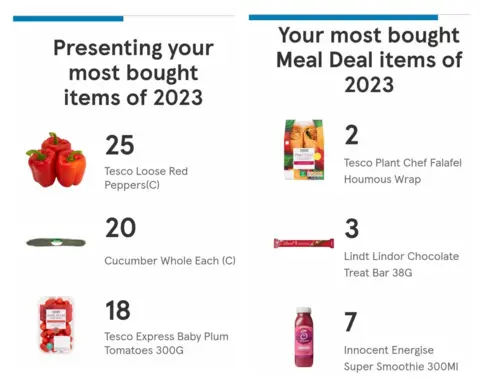 Getty Images
Getty ImagesThroughout December, Instagram feeds are flooded with pictures of Christmas trees, snaps from festive work parties – and screenshots of people’s most-listened-to songs of the year.
That’s because at the end of every year, since 2016, Spotify releases Wrapped. The campaign pulls together what users listened to the most and usually includes their top songs, artists, and genres.
It’s now “plastered across every possible social media platform known to man,” says Dr Gillian Brooks, a lecturer in strategic marketing at King’s College London.
She says its Wrapped feature works so well because music is personal and people enjoy the nostalgia of seeing the songs that marked their lives over the past year.
Since Wrapped goes viral annually, other businesses have joined in, from language learning app Duolingo to bank Monzo, all creating their own personalised “year in review” summaries – alongside other music streaming apps such as Apple Music and Amazon Music.
Prof Jonathan Wilson, a professor of brand strategy and culture at Regent’s University London, thinks there is an ulterior motive for people sharing these end-of-year-reviews – especially on apps that people use to track their virtuous activities, like fitness and education.
“It’s like bragging but without the selfie,” he explains. “Lots of people don’t want to take selfies for various reasons but one of them is that people feel a bit cringe, that it’s a bit narcissistic.”
People share information on social media if it “enhances the image we wish to portray publicly of who we are and what we want to align ourselves with”, he says.
Apps like Strava will tot up how far you have run or cycled this year, while Duolingo will tell you how many hours you’ve spent learning another language.
Goodreads provides you with images you can share on social media displaying the books you have read this year, with details about the average page length and your top genres.
“Data is a really good way to humblebrag, as opposed to actually taking selfies in all of your best clothes surrounded by all of your best people and belongings,” Prof Wilson adds.
“It’s less like bragging and a bit more evidence-based,” agrees Prof Caroline Wiertz, a professor in marketing at City, University of London.
Spotify Wrapped is part of the festive calendar
 Getty Images
Getty Images“This is a thing now in the calendar,” Prof Wiertz says. “We wait for the John Lewis Christmas ad, we also wait to receive our Spotify Wrapped.”
Other brands jumping on the bandwagon include Tesco and Sainsbury’s for your favourite groceries, Trainline and Uber for your most frequent journeys, Monzo and Lloyds for your spending habits, Xbox and Nintendo for your gaming.
Prof Wilson tells the BBC this copycat behaviour was inevitable – the prospect of people promoting a company or product seems like too good an opportunity to miss.
As Dr Brooks says: “It’s free advertising for them.”
Some year in review features are more tongue in cheek, which brands hope can make them more relatable, and shareable, to their customers, these experts say.
People typically don’t post information about their financial situation on social media. But Monzo has found a way to make its year in review sharable, by telling people whether they’re among the top spenders at Greggs.
Reddit tells users the distance they’ve scrolled, measured in bananas.
And though Prof Wilson says that people typically don’t want to post mundane things on social media, like “which kind of bread roll they bought,” Sainsbury’s shows shoppers whether they were the top buyers of certain products in their local area.
It has led to people boasting online about being the top consumer of paprika, toilet cleaner or pickled gherkins.
 Tesco
TescoYear in review features can raise questions about just how much data companies collect. It is widely understood that the vast majority of apps and websites someone might use are collecting huge reams of data, which they use for marketing purposes.
Dr Brooks suggests “people blindly accept privacy preferences online” because they want to get on with whatever they visited the website to do.
Data privacy is “not as huge of an issue as it used to be”, she says. “If we get more targeted adverts as a result, most people I’ve spoken to are okay with that.”
And though people like to keep some information about themselves private, they seem to have few qualms about sharing their hobbies and leisure activities online.
“Paradoxically, when you share a selfie you are sharing far less information about yourself than you do with data showing what you do,” Prof Wilson says. “People seem more comfortable with doing that than sharing a picture of themselves.”

